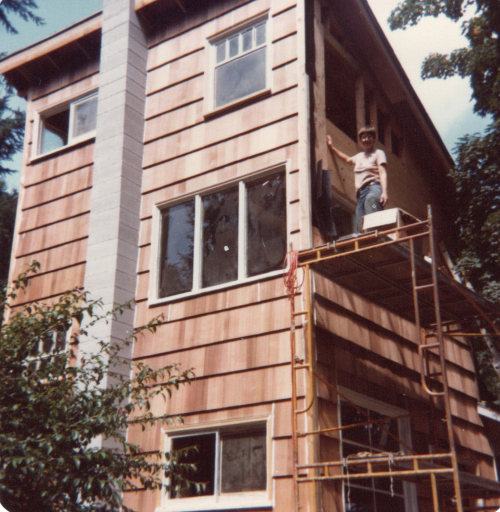WORK
LLyn’s Tower: An All-Woman Construction Project – 1979
Interview By Jean Eberhardt
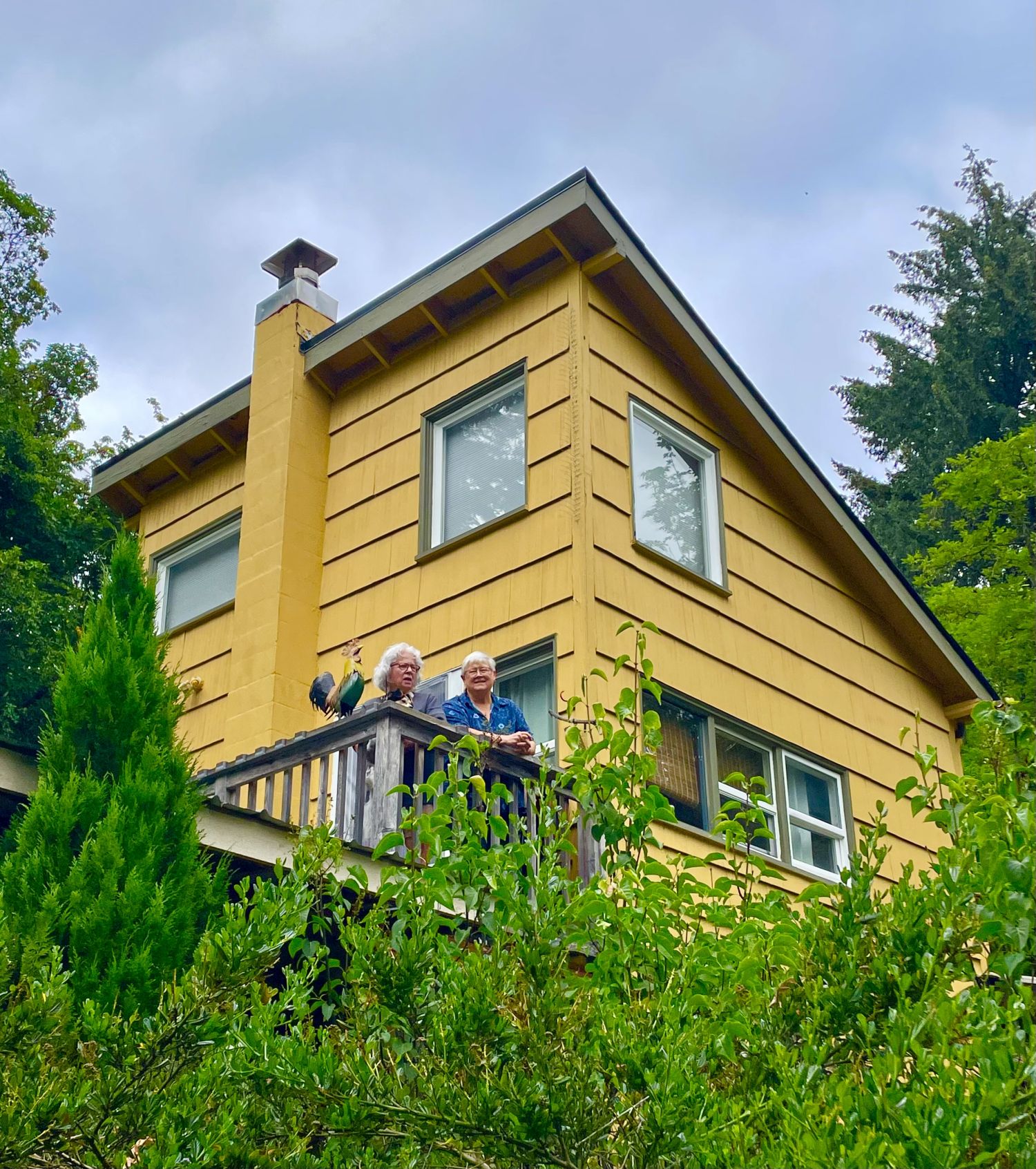
LLyn De Danaan (formerly known as Lynn Patterson), Anna Schlecht and I got together for an interview at LLyn’s house, but it quickly morphed into a boisterous reminiscence of the time that Nozama Construction (Carol Elwood, Cathy Cox, and I), the newly minted construction collective I was part of, came to build an addition on her house to accommodate her growing family. Forty-five years later, this two-and-a-half-story addition, affectionately referred to as a tower by LLyn, still stands. I have taken a few liberties with the transcription for clarification.
Anna: What inspired you to do this addition?
LLyn: It was 1979. I was in a new relationship and had completed all the paperwork and home visits for an adoption. My life was changing very rapidly and then five-year-old Ricco came into my life from Colombia. My partner then, Sally Cloninger, moved to my house not long before he arrived. And so suddenly, I went from being perfectly happy in my small house, to the three of us living in my small house on Oyster Bay. Was it working? There was room enough, sort of, but obviously I concluded that it was time to build an addition to this house because I didn’t want to move. And so I started thinking about how that could happen. And then I forget what happened next, except y’all came out and built it.
Jean: I don’t know how we first found each other but I think we did the contract signing downtown at the Herb and Onion. You had plans already drawn up before we did that.
LLyn: It was me. I drew up the plans because that’s what I’ve always done on this house.
Jean: Did we get a permit for this project?
LLyn: I don’t know. We’re in Mason County. And probably we didn’t. I don’t think most things that I’ve done on this house have been permitted. Yes for the septic system and yes for the well. All of that kind of stuff. But in terms of building this, no.
Jean: That’s hilarious!
LLyn: There was a breaking point with three people in that small house. And we were like “we have to get this up as soon as possible”. So the inspiration was three people in a house that was just fine for one. Sally was willing to help. A gang of friends from Evergreen did the sheet rocking. I did the wiring. My father was an electrician. He stood to the side and told me what to do . . . I went under the house and above and I pulled all the wires and I did all the wiring. I ran a drill bit all the way through my right arm. No scars. But the wiring and sheetrocking was after y’all had framed it up, of course. And as I told you yesterday, or this morning whenever, I told you the windows, right? There was a junk shop in Shelton on the far side of town, where Marilyn Frasca and Susan Christian and I used to go all the time. We didn’t buy anything new. We’d go to this place, this junk shop, and whatever we needed we’d go find something that would work and we get things, so I just collected a whole bunch of windows for the tower and you had to figure out where to put them.
Jean: Are you serious? You didn’t even tell us what windows you wanted where?
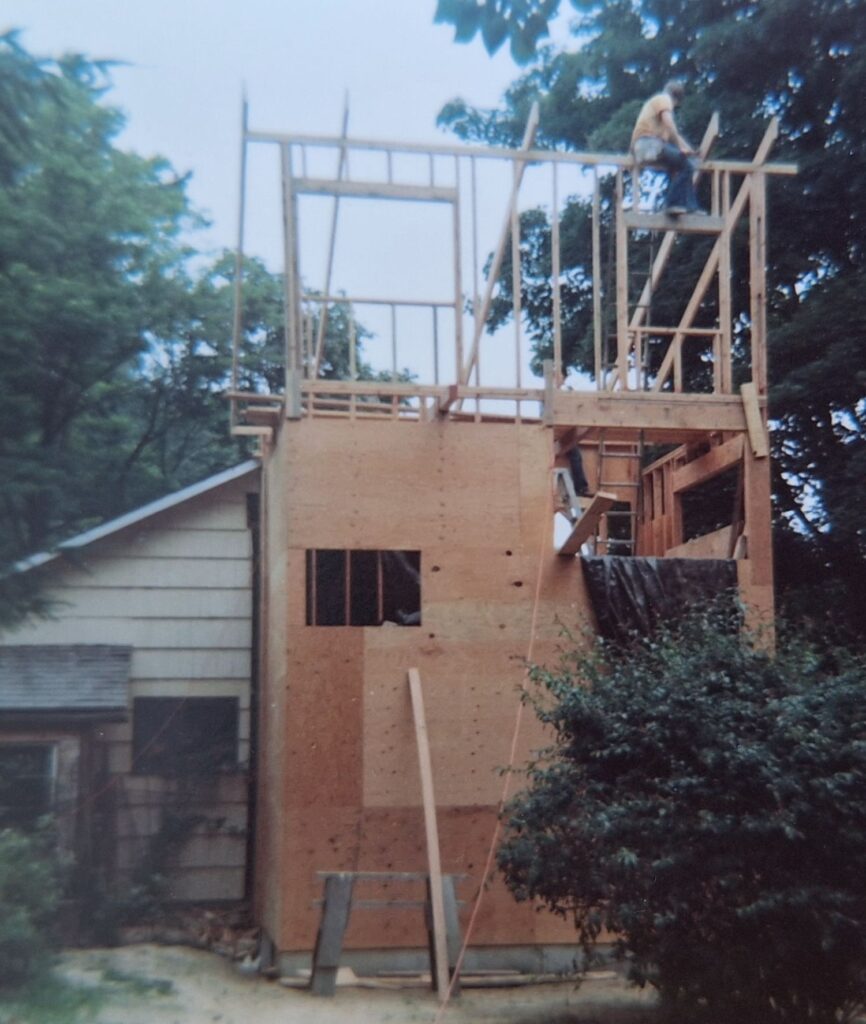
LLyn: I mean, we talked about it together, but there were a whole lot of oddly shaped and placed windows because we were dealing with the windows I bought with very little forethought. And they were, you know, wooden windows. They were okay. There was no broken glass but you had to deal with whatever I had managed to purchase and collect. Right, basically it. Yeah.
Jean: Did Sally want to work with us or did she just want to help out?
LLyn: Sally was willing to help out with whatever needed doing after the structure was built. She was teaching and I was teaching, both at Evergreen, and we were learning how to be parents to this little guy. You know, it was a very busy period and you know, for me, big life changes and yeah . . .
Jean: Well we started in the spring. It might have been May, but I know it was in the spring and we thought we’d be done fairly quickly. The expectation was that we would certainly be done by the end of summer and we weren’t. All we were doing was framing and weathering it in. You all did all the inside stuff. But it really did take our novice crew a while! A dull memory of five months is stuck in my head.
LLyn: You were here every day for a long time. And here’s what I really remember . . . So there used to be a long sort of garage shed out there. Yep. With kind of barn doors and I had had somebody pour a concrete pad for basketball. Remember that? And there was a basketball hoop and y’all would come out here in the mornings and strip (peels of laughter), no, really you stripped and did exercises over on that pad.
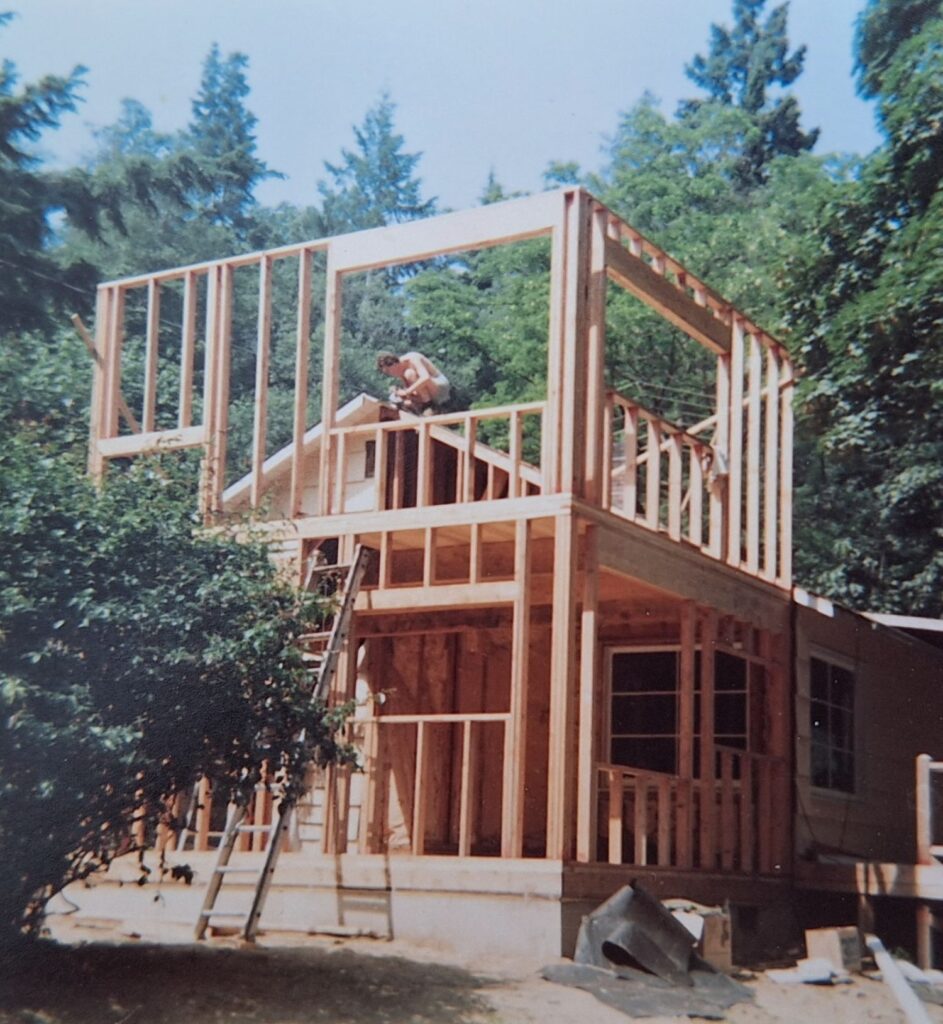
Jean: Just our shirts, right? Recently, we’ve reconnected over this community memoir, and you mentioned watching the crew, you know, do our stretching . . . that was pretty funny to me because I didn’t remember we took our shirts off nor do I remember that you watched us! Yeah. It was a nice way to start our work days.
LLyn: Whatever it is you were wearing, I have a memory of bare breasts. Bare-breasted on the cement pad doing push ups and sit ups and jumping jacks before you’d go to work. You warmed yourselves up that way. I thought it was funny.
Anna: I was here. I was one of those bare-breasted carpenters., remember?
Jean: Weren’t you part of Artemis Construction then?
Anna: Jean, did you forget that I worked on this project too? I was actually on the Nozama business card; well now that I think about it, that happened later on. I remember the long drive out here. Back in those days the house was not yet engulfed by trees and shrubs like it is now. We all became part of the family because there’s is an intimacy in the remodel process. I first experienced this jobsite-kinship as a carpenter when I was showing up every day to do the work. Later on, I experienced it as a City building inspector, because I still felt like I got pretty deep into the lives and families of the people who were getting their homes fixed up through the City’s housing program.
LLyn: That’s an interesting perspective, about the intimacy of working relationships while doing remodels and, yeah, while people are living in the home.
Jean: I remember something as the project dragged on. Cathy and I broke up, so then she left the job. And it was just Carol and me, so maybe that’s when we pulled you in Anna, for some bit of time. But I remember it being mostly Carol and me. We were still working here and this place wasn’t ready. And you, LLyn and Sally, were champing at the bit to wire, insulate, and sheet rock it to move into.
LLyn: Well, I have to tell you this doesn’t have to do with that directly except to say that I have always been so proud to tell people that you all built this house and that you were going to do buildings in Nicaragua. I feel as if I contributed to that effort. Didn’t you build something for Caryn Cline in Seattle?
Jean: That may have been with the Seattle Construction Brigade that I joined in 1985.
LLyn: Somebody did a building for her at the back of her house.
Jean: So that was the summer of 1985. When I got involved with that group, some of our fundraising in Seattle was through working on building projects together. Okay, it was other builders on the brigade that were organizing those projects. I was just showing up to work on them on weekends. It brought us more together as a group. I ended up going a month ahead of the brigade to Nicaragua to receive the shipment of tools and materials we sent out of Canada and to set up our housing and transportation.
LLyn: Caryn Cline eventually came to Evergreen. So the Nicaragua link was one we shared. I always tell people about this and the connection with political aims and I’ve always been very, very proud of it. I couldn’t have been more delighted to have you do this house. So I always thought of this as your practice run. There was never anything that I thought of as “Oh, that’s terrible and they didn’t do this right.” I’ve never felt that way because I thought of it as a practice run. And it was like one tiny way I could contribute. You know, because I was the owner of the house. Have always been sole owner. This was me. This is all me. This addition, my little political act to hire you. And yeah, cool.
Jean: That’s really thoughtful, LLyn.
LLyn: Good. Okay, let’s get back on it. Maybe we should walk around both inside and out and see if that jogs any other recollections? Yeah, why go inside? Because you could talk about the stairs . . .
Anna: I just walked off the patio and looked up to get an idea of the height of this tower. I remember thinking not only was this a first project for Nozama but it was a tall project. A very, very tall project. Falling from a one-story ladder would hurt you and maybe break a bone, but falling from a two-story ladder you could die!
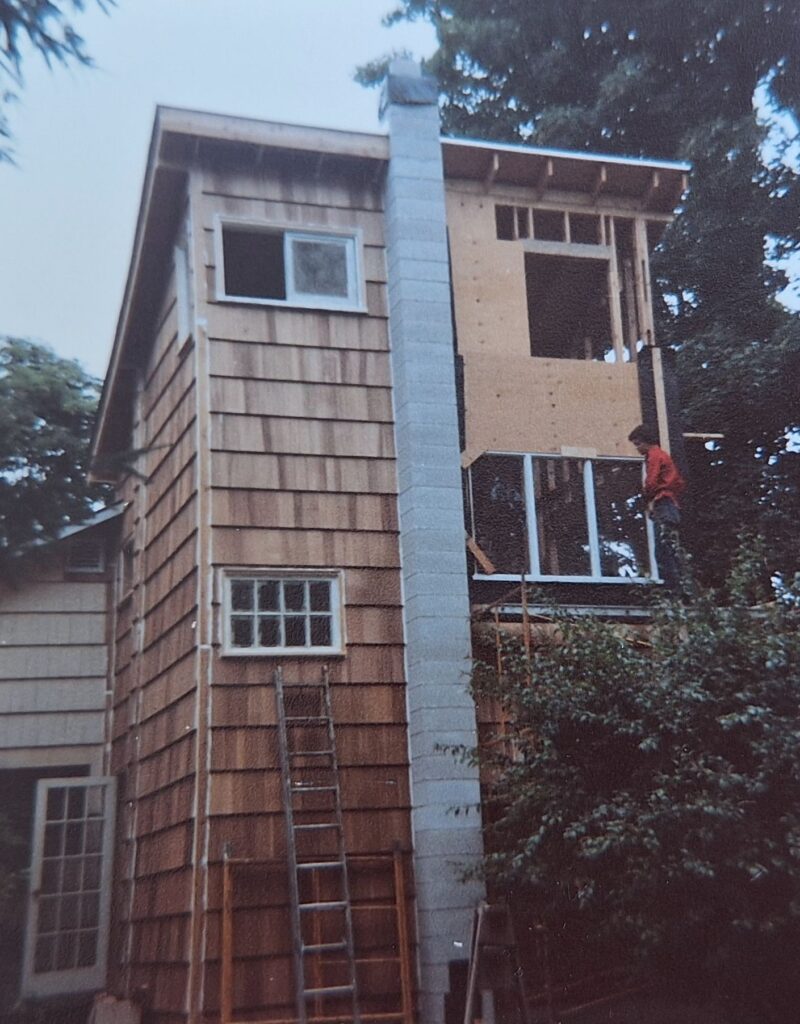
LLyn: See that window way up there? That one was falling out of the frame. Yeah, that one just didn’t want to stay in. But actually, it was a replacement window that was falling out. It wasn’t the one you put in. Shelton Mason County had an energy savings vinyl window replacement program and all these double-paned windows were free to me because of that program. So yeah, these are all the same configuration. You can see these are the original frames. but that high one was falling out after they replaced it. Yeah, so we had to get that fixed.
Jean: I’m just looking at some of these sills that don’t have a drip edge under them. Oh, here’s one. Here’s a drip edge. Look up there at that window that doesn’t have one. This is so the water doesn’t just get wicked back under. There’s a little slot underneath that’s an important part of wooden window sills.
LLyn: Maybe that’s what was missing for that one that leaked.
Anna: I love your patio by the way, there’s just so much to discover everywhere you look. I bet your grandkids are in heaven when they come here.
LLyn: Yeah, I think they’ll probably sleep outside this time. Well, they’re, you know, they’re not kids anymore. They love coming here.
Jean: Somebody else came in to build this tall chimney and then we ran the cedar shingle siding up to the masonry. It could use some new caulking. I remember thinking that we didn’t want the shingle siding to come right down and sit on top of the flashing on top of the windows because it could hold water there. So we left these ⅜” slots on top of the windows, which looked bad. Since then, I think somebody else has smartly filled those gaps in with caulk.
LLyn: All right, well, let’s do the walk around inside.
Anna: I poked around a little bit when I walked in to go to the bathroom earlier. Your home is really beautiful.
Jean: So, here are the stairs that have haunted me for 45 years. As acknowledged, we were novices. We’d never built an interior staircase and we were nervous about placing a middle jack to support the treads. What if it made the stair treads uneven and squeak? If they’d been enclosed stairs, we could have shimmed and glued our way out of the situation. But we used 1 ½” thick tongue-and-groove decking for the flooring as well as the stair treads. When your father, the electrician, asked you about the “missing jack” and then you asked us, I fumbled my response and I remained chagrined for decades, until you recently told me to just let it go. The stairs haven’t gone anywhere and you still love your tower. Thank you for hiring this earnest group of dyke-identifying women (at that time) to build for you. We learned a lot, had some really great times and I kept Nozama Construction going for 17 years. All subsequent staircases got middle jacks!
Jean’s footnote: It was an honor to work on LLyn’s tower as our first job as general contractors. Back then, a person could get licensed and bonded and not know a lot about building. It took me a long time to figure out that many of the “guys” were also full of bravado, stretching their skills as they learned and became more proficient at the craft. Nozama Construction was part of a nation-wide movement of women in the trades challenging gender norms. I’m proud to have joined my grandmother* and the ranks of women pushing through these barriers.
*Anna Beseau Eberhardt was a machinist in a California aircraft factory from 1943 to 1971..
We encourage readers to contact us with comments and corrections. Disclaimer

